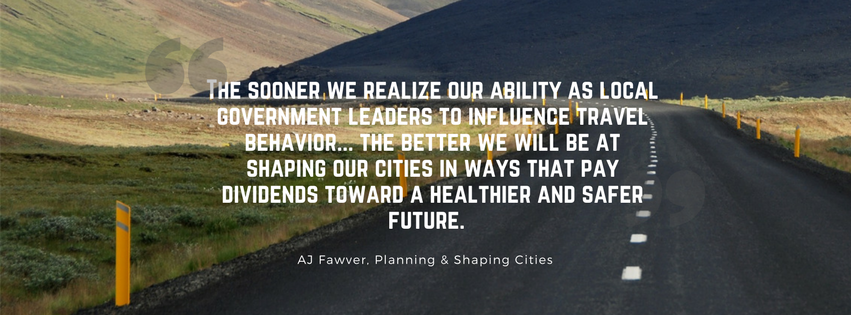
 This is a new monthly blog by AJ Fawver, the Planning Director in Amarillo, Texas. She’ll share her perspectives on land use, planning, and community development in this series. Learn more about AJ from her GovLove interview!
This is a new monthly blog by AJ Fawver, the Planning Director in Amarillo, Texas. She’ll share her perspectives on land use, planning, and community development in this series. Learn more about AJ from her GovLove interview!
Human behavior is fascinating, isn’t it? Even more fascinating, however, is the way that the planning of land use and transportation networks can influence human behavior. It is true that many planning decisions are made from the vantage point of responding to an existing issue or trying to mitigate an inherited condition. Nevertheless, it is also true that too often, we do not take the time to adequately think about the way those decisions are influencing the behavior of those traveling to, within, and through our city.
How can these decisions influence travel behavior? So glad you asked.
If you’re working for a city which intends to encourage multi-modal transportation, the decisions made – from policy making to capital improvement projects – determine in large part if people living there will (or can!) pursue other modes of transportation, such as bikes, public transit, or walking. To use those alternate modes, they must be made available.
Or, think about access management for a major corridor in your city. With a proper access management policy in place, a coordinated approach to shared access for those businesses can be undertaken. Without one, however, what has promise as an efficiently operating corridor will quickly become a mess of driveways and conflict points, and motorists will be left uncontrolled in their movements, leading to traffic accidents and greatly hindering pedestrian safety.
The choices made in planning that corridor determine how much choice is available for each motorist, and therefore, influences their movements and behaviors.
The allowable density of development is something that is also an influencing factor. Walkable employment centers with retail offerings nearby, as an example, lessen reliance on the car. As a result, centers of human scale activity, which is attractive to others who want to be experience that activity, emerge. “Places” are created where people may want to linger.
Likewise, connected residential areas with neighborhood services nearby have a more positive influence on travel behavior than a series of cul-de-sacs which necessitate a drive to an area with retail development.
Many communities are notorious for having extra wide streets, straight and long, much like drag strips. As such, drivers behave as though they are driving on drag strips – they race. On the other hand, by adopting policies and ordinances which require narrower streets, bordered by landscaping, bike lanes and meandering sidewalks, drivers slow their speeds, while pedestrians and cyclists feel safer and more protected; this further encourages a mix of activities and modes, creating an attractive outdoor environment.
The impact of travel behavior on health is another oft-overlooked but crucial piece of the puzzle. In a society where we are increasingly obese and unhealthy, the likelihood of combating that with regular outdoor activities – such as walking and utilizing recreation areas – is only as good as the access to those very amenities.
Furthermore, as we begin having more productive discussions regard climate adaptation and realize the impact of vehicle travel on the environment, the way we plan neighborhoods and connect them to centers of business and recreation are crucial to reducing those vehicle miles traveled.
The sooner we realize our ability as local government leaders to influence travel behavior, and to realize the great responsibility and opportunity that comes with that ability, the better we will be at shaping our cities in ways that pay dividends towards a healthier and safer future.
The decisions we make are important, yes, but the influences those decisions create are long lasting and impactful. Like it or not, adaptation continues to be one of the most crucial skills we can build on behalf of the communities we are planning for.
Take a look at the policies and ordinances in your community. Do they adequately take into account the influences they create? Are they in line with a philosophy of providing opportunities for all modes of transportation as a means of travel? Do they promote safety and public health? If you haven’t asked these questions before, now is the time for investigation and reflection.
There are great resources online, such as the Smart Growth Network, City Observatory, and Reconnecting America. There are also a number of experts who have written on this topic, including Todd Litman, Reid Ewing and Robert Cervero, Ivan Semeniuk, and Jonathan Lerner.
Do a little reading and allow their findings and observations inspire you in your day-to-day work. Discuss with your colleagues and explore the possibilities. Taking or revisiting a more active role in how cities better function is always a positive step.
Questions? Want to get in touch with AJ?
